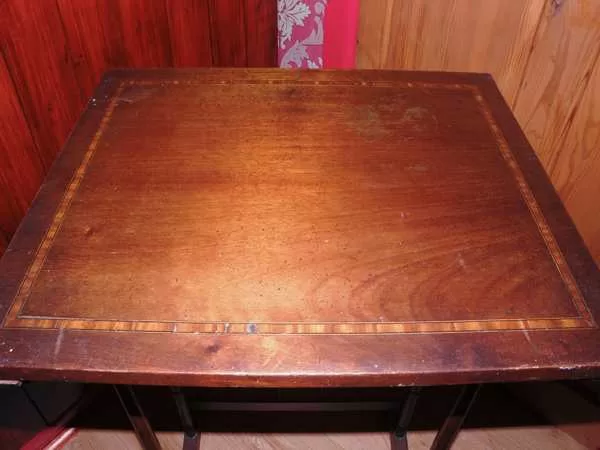Today’s discovery is a captivating Regency-style side table, radiating elegance and a hint of mystery. Crafted in what appears to be rosewood, it boasts a satinwood inlay on the top and graceful ring-turned legs.
Clues Point to a Quartetto: Nesting Tables in Disguise?
Two intriguing details suggest this table may be part of a larger set. The first is the presence of stretcher rails only at the back. A single standing table typically features stretchers on both the front and back. Their absence here implies a deliberate design choice, perhaps to allow other tables to nest beneath it.
The second clue lies on the underside. Channels lined with felt strips are present on either side of the tabletop. These channels, designed to protect something sliding in and out, further strengthen the theory of missing nesting companions.
A Replacement with a Story to Tell:
One of the elegant slipper-style feet has been replaced, breaking the table’s original symmetry. The contrasting finish and crude screw attachment indicate a quick fix rather than masterful restoration. While not readily apparent, it adds a layer of history to this piece.
Color Clues and the Evolution of Nesting Tables:
The table’s uniform color hints at its place within a quartetto. The largest table in such sets often exhibits a lighter top due to sun exposure. Nesting tables, however, would be shielded by those above them, resulting in a more consistent color.
Nesting tables, initially plain in design, evolved throughout the 19th century, becoming more ornate before a return to simpler forms in the Edwardian era. Modern versions typically come in sets of three.
A Treasured Find with a Caveat: The Value of Personal Preference
This table, purchased from the same seller as the bureau for £21.59, may not have garnered the same price tag with an in-person inspection. However, the act of discovery and the potential restoration project hold a unique value. An insightful analogy highlights this sentiment: while £20 might buy a mediocre meal and a bottle of wine, the satisfaction of owning and restoring a piece of history far outweighs such a fleeting pleasure.

